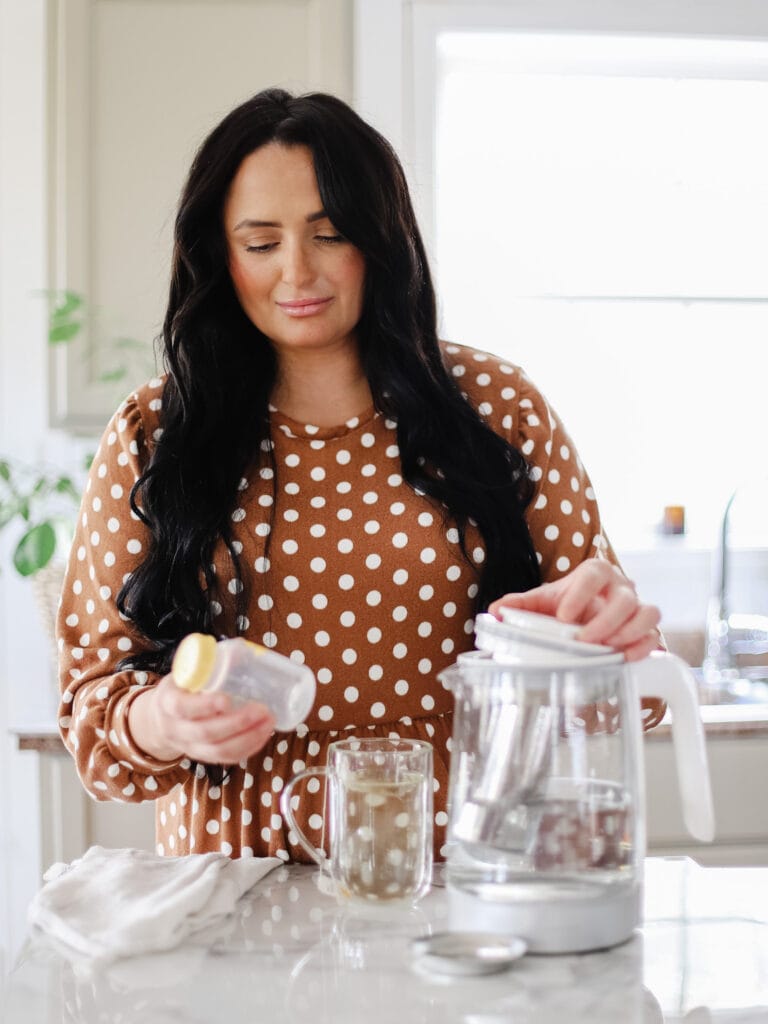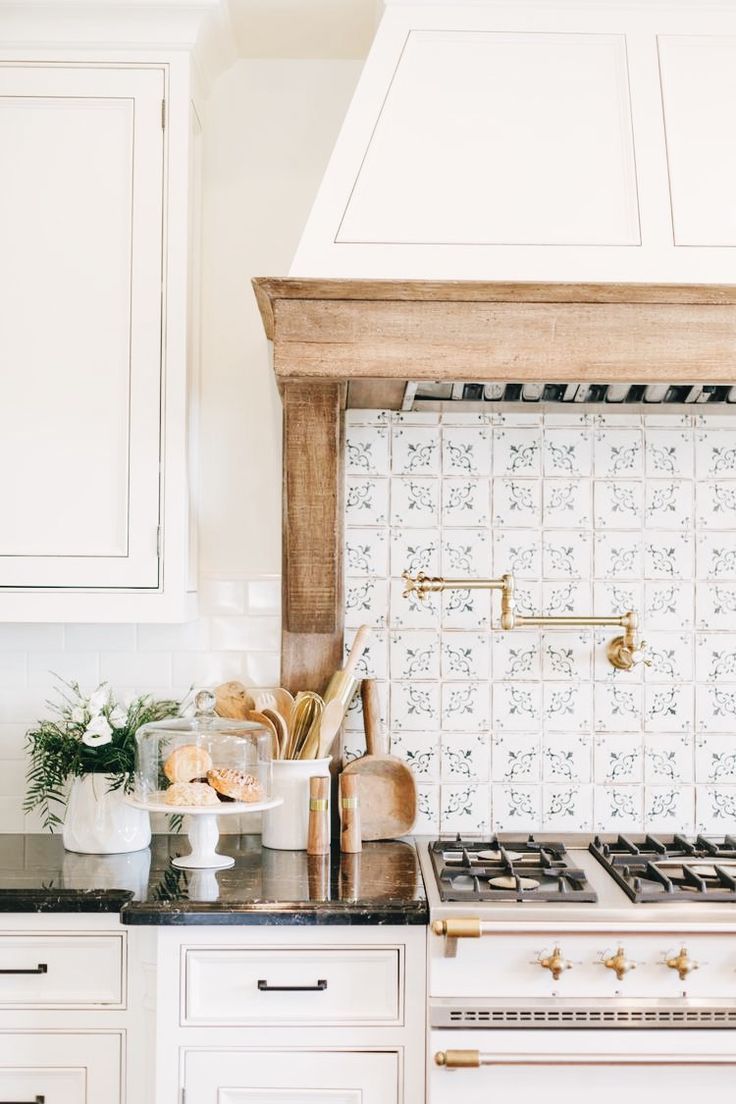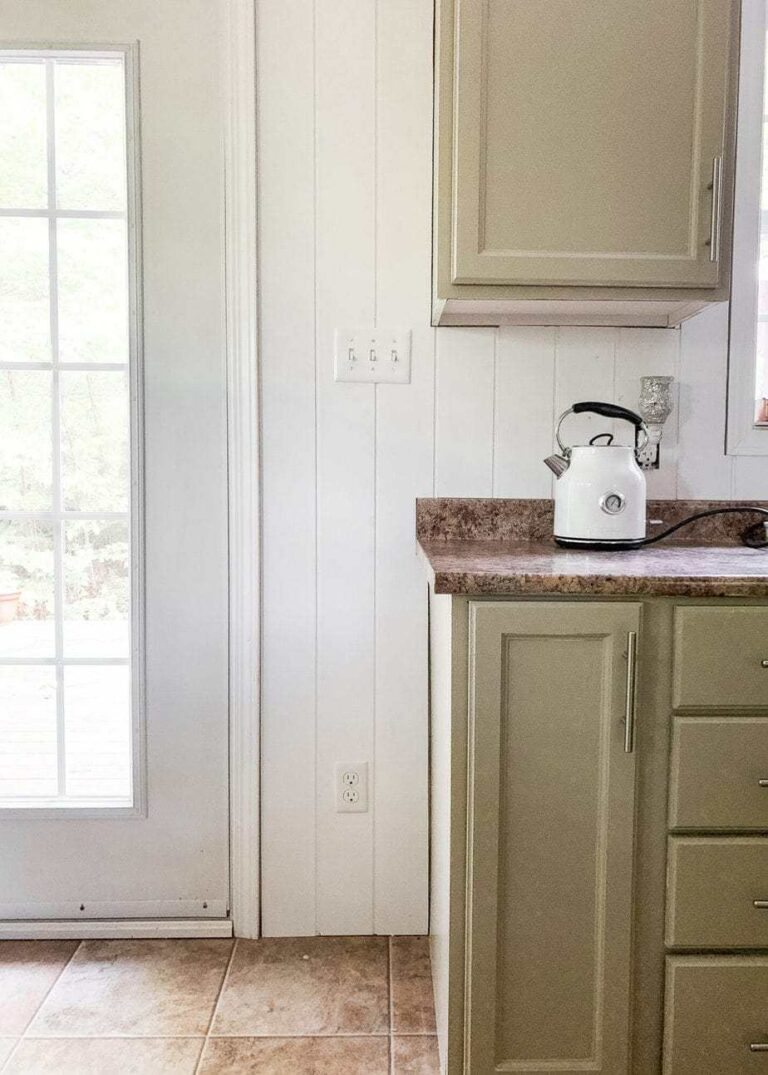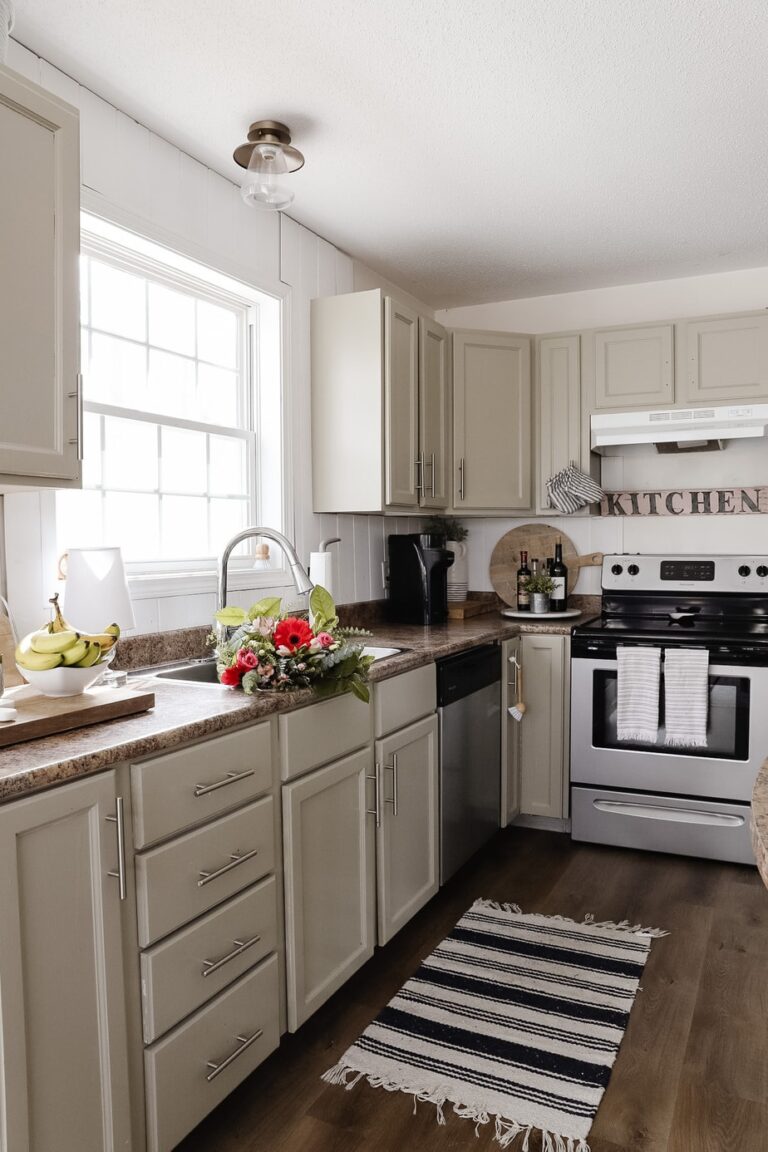What do you do with Appliances in a Small Kitchen?
Post Summary: Today we’re dishing (see what we did there!) on how to arrange appliances in small kitchen spaces like ours and many others.
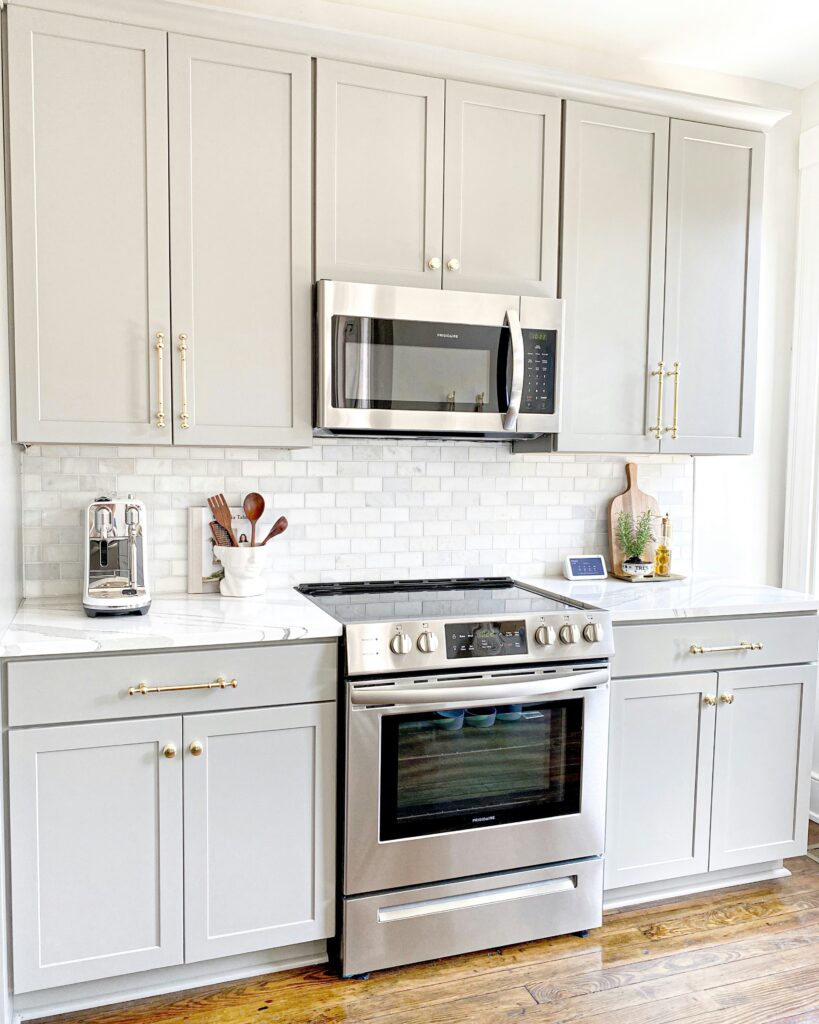
One of the most asked questions we get about my sister’s tiny home build is about the kitchen, and rightfully so! It’s a small space and we need to optimize every inch of space we possibly can. Which is why arranging appliances in a small kitchen can be a daunting task. With limited counter space and storage, it can be difficult to find a place for everything. But, with some strategic planning and organization, you can optimize your kitchen’s layout and make the most of your space.
First, consider the layout of your kitchen. If you have a galley kitchen, for example, you may want to place your appliances on opposite sides of the room to maximize counter space in the center. If you have a U-shaped kitchen, you may want to place your appliances in a triangle formation for easy access and efficiency.
Next, prioritize your appliances based on frequency of use. Your most frequently used appliances, such as your refrigerator and stove, should be easily accessible and have ample counter space around them. Less frequently used appliances, such as a slow cooker or blender, can be stored in cabinets or on shelves to free up counter space. By prioritizing your appliances, you can ensure that you have the necessary space and accessibility for your daily cooking needs.
Keep reading to learn how to maximize valuable space and countertop real estate in the kitchen by figuring out how to arrange appliances in a small kitchen.
Understanding Your Kitchen Space
When it comes to arranging appliances in a small kitchen, the first step is to understand your kitchen space. This means assessing your cabinet and countertop space, as well as maximizing your vertical space and storage solutions.
Assessing Cabinet and Countertop Space
Start by taking a look at your kitchen cabinets and countertops. Determine how much cabinet space you have available and how much of it is being used. Consider which items you use most often and whether they are easily accessible.
Next, assess your countertop space.
Are there any appliances taking up valuable counter space that could be stored elsewhere? Consider which appliances you use on a daily basis and which ones can be stored away when not in use.
Maximizing Vertical Space and Storage Solutions
In a small kitchen, it’s important to make use of every inch of space. This means maximizing your vertical space and utilizing storage solutions such as shelves, hooks, and baskets.
Consider installing shelves above your countertops or cabinets to store items that are used less frequently. Use hooks to hang pots, pans, and utensils on the walls or under cabinets. Utilize baskets to organize smaller items such as spices or cooking utensils.
When it comes to kitchen storage, it’s important to make the most of your cabinet space. Use stackable organizers to make the most of your shelf space and consider installing pull-out drawers or lazy susans to make it easier to access items in the back of your cabinets.
By understanding your kitchen space and utilizing smart storage solutions, you can make the most of your small kitchen and arrange your appliances in a way that is both functional and efficient.
Be Ruthless and Declutter
Sometimes, we simply have too many small kitchen appliances that even precise organization cannot fit. We encourage you to evaluate the need for the many gadgets and appliances you own.
Do you use the rice cooker frequently? What about the stand mixer you were gifted ten years ago? It’s always a good idea to start a project such as kitchen organization by asking yourself the hard questions about some of the items that have been living at the back of that lower cabinet, especially if you are considering adding any new appliances into the mix.

Our household now has a one-in, one-out rule for clothing, shoes, appliances, and toys.
Another thing we want to mention is not to get caught up in fads. Pressure cookers had a moment, and now the air fryer is considered a kitchen staple. Before purchasing a new appliance, ask yourself if you will truly maximize its usage, or if it’s just a fad.
Strategic Appliance Placement
When it comes to arranging appliances in a small kitchen, strategic placement is key. By placing your appliances in the right locations, you can maximize your space and make your kitchen more functional.
Determining Appliance Frequency of Use
Before you start placing your appliances, it’s important to consider which ones you use most frequently. This will help you determine where to place them for easy access.
For example, if you use your food processor every day, you’ll want to keep it on the countertop where it’s easily accessible. On the other hand, if you only use your toaster oven occasionally, you can store it in a cabinet to free up counter space.
If you haven’t used an item in a calendar year, it may be time to consider donating it. Out of sight also usually means out of mind, so if you haven’t reached for it in over a year, chances are you never will.
Creating Zones for Food Preparation and Cooking
To make your kitchen more efficient, it’s helpful to create zones or a designated area for food preparation and cooking. This means grouping your appliances together based on their function. For example, you might have a prep area where you keep your cutting board, knives, and food processor. You might also have a cooking area where you keep your stove, oven, and pots and pans.
By creating these zones, you can streamline your meal preparation process and make it easier to move around your kitchen. You can also use this strategy to determine where to place your appliances. For example, you might keep your coffee maker near your breakfast nook so you can easily grab a cup of coffee in the morning.
Overall, strategic appliance placement is essential in a small kitchen. By considering appliance frequency of use and creating zones for food preparation and cooking, you can make the most of your space and create a functional kitchen that meets your needs.
Innovative Storage and Organization
When it comes to arranging appliances in a small kitchen, utilizing innovative storage and organization solutions can make a big difference. Here are a few ideas to help maximize your kitchen’s storage space.
Utilizing Appliance Garages and Pull-Out Shelves
Appliance garages and pull-out shelves are great options for storing small appliances and keeping them out of sight when not in use. Appliance garages are cabinets with doors that open upwards, providing easy access to your appliances while keeping them hidden from view. Pull-out shelves, on the other hand, are shelves that slide out from a cabinet, making it easy to access appliances stored in the back.
Installing a magnetic strip might be the perfect solution and an efficient way of storing frequently used utensils.
Magnetic Knife Strip
A magnetic knife strip is a great idea for small kitchens, to help you optimize your space better.
Check it out >
Implementing Shelf Risers and Lazy Susans
Shelf risers and lazy susans are simple yet effective solutions for organizing your kitchen cabinets. Shelf risers allow you to stack items on top of each other, effectively doubling your storage space. Lazy susans are rotating trays that make it easy to access items stored in the back of a cabinet.
Clear Lazy Susan
This two-tier lazy Susan is perfect for optimizing your small kitchen space. Giving more room to things like appliances and other necessary items in your kitchen.
Check it out >

By implementing these storage and organization solutions, you can make the most of your kitchen’s space and keep your appliances and other items easily accessible. Don’t forget to also consider utilizing cabinet doors, deep drawers, and pantry shelves for extra storage. If you really want to take your kitchen organization to the next level, consider investing in a kitchen organization system that is tailored to your specific needs.
Selecting and Prioritizing Appliances
Choosing Appliances for Small Kitchens
When it comes to arranging appliances in a small kitchen, you need to be strategic in your choices. Bulky kitchen appliances can take up a lot of space, so consider opting for smaller appliances that can perform multiple functions. For example, a blender can also be used as a food processor, saving you valuable counter space.
When selecting appliances, think about what you really need versus what would be nice to have. Kitchen gadgets and tools are great, but if you have numerous small appliances, you may end up sacrificing counter space and storage. Prioritize the appliances that you use the most and consider donating any that you rarely use to a local charity.
Magic Bullet
This is a great mini blender for smaller kitchens. Not only does this blender come in a small size but it comes with all the additional items you need.
Check it out >
For items we use only once or twice a year like our waffle maker, crock pot, instant pot, etc, we store these items in a clear bin in the storage room so the items do not take up valuable shelf space in a tiny kitchen.
Deciding When to Upgrade or Downsize
If you’re working with an existing set of appliances, it’s important to evaluate whether they are meeting your needs. Are they taking up too much space? Do they perform the functions that you need them to? If not, it may be time to consider upgrading or downsizing.
When upgrading, look for appliances that are designed for smaller kitchens. Many manufacturers now offer compact versions of their popular appliances, such as refrigerators and dishwashers. These appliances are typically designed to be more space-efficient, without sacrificing functionality.
On the other hand, if you find that you rarely use an appliance, consider downsizing. This can help free up valuable counter and storage space. If you’re not sure whether an appliance is worth keeping, try going without it for a week or two. If you don’t miss it, it may be time to let it go.
Final Touches for a Well-Organized Kitchen
Incorporating Decorative Elements and Practical Tools
A well-organized kitchen not only functions efficiently but also looks aesthetically pleasing. Incorporating decorative elements and practical tools can help you achieve both goals. For instance, you can use a kitchen island to add valuable counter space to your kitchen. A kitchen island can also serve as a focal point and a decorative element in your kitchen design.
Another way to incorporate decorative elements and practical tools is by using wall space. You can install shelves, hooks, or rails to store and display your kitchen tools, such as pots, pans, and utensils. This not only saves precious counter space but also adds a decorative touch to your kitchen layout.
Maintaining Organization for Daily Efficiency
Maintaining organization in your kitchen is essential for daily efficiency. You can do this by carefully planning the placement of your appliances and kitchen tools. For instance, you can place your frequently used appliances, such as your coffee maker and toaster, in a good way that is easily accessible on your countertop.
You can also use clever ways to store your kitchen tools, such as using drawer dividers or organizers. This ensures that your tools are easily accessible and organized, which saves time and energy on a daily basis.
In addition, it is important to regularly declutter and clean your kitchen to maintain organization. This can be done on a daily or weekly basis, depending on your preference. By doing so, you can ensure that your kitchen functions efficiently, and this is a great way to start your day.
Small kitchen organization when you have limited free space can feel overwhelming. With careful planning, your kitchen cabinet storage space can be used effectively for daily use.



